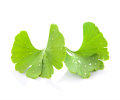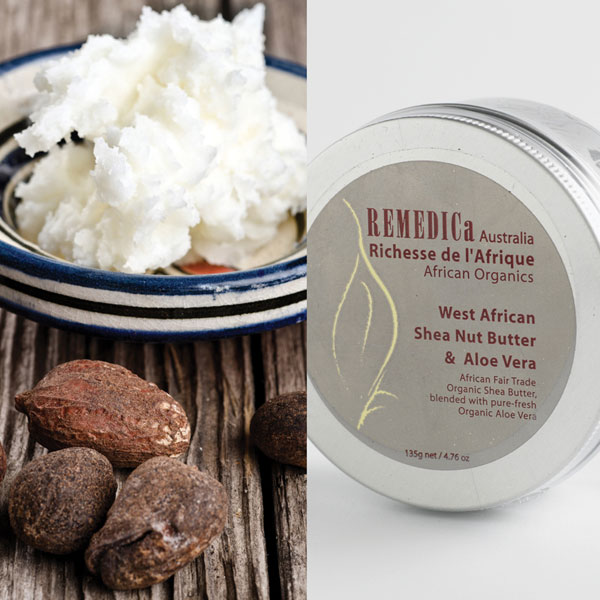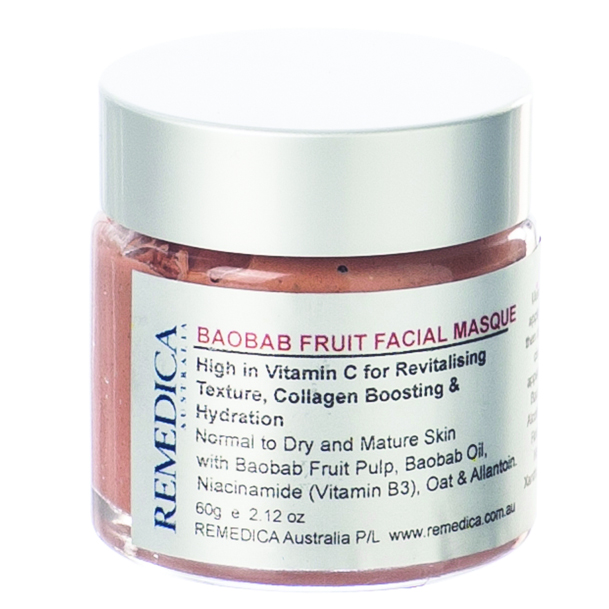Ingredients
Ingredients Listing and Glossary Alphabetically
| Ingredient Name | Class / Type | Notes |
|---|---|---|
Aloe Vera | Class: Extract Function: Soothing, Anti Irritant and Anti inflammatory, Healing and reinforcement and Hydrating. | NB: Aloe vera can be supplied as dry powder or liquid form (sometimes containing preservatives – thus enabling some “marketers of product” to claim “preservative free”. REMEDICa grows and harvests their own certified organic aloe barbadensis plants and predominantly uses fresh filleted gel from leaves and preserves with food grade potassium sorbate. |
Baobab Oil | Class: Fixed Oil Cold pressed and made from the seeds of fruit of the baobab tree. Contains a high amount of vitamin D to nourish the skin. | NB: Good source as well of vitamin A, E and F and Essential Fatty Acids (EFA’s O-3, O-6, O-9) comparable to Rose Hip Oil but lighter in weight and faster to absorb making it more suitable for oily, congested and irritated skin. REMEDICa only uses the pure unrefined version of this oil displaying a light natural nutty odour. |
Caprylic Acid | Class: Non-Volatile (Modified Oil) Typically a refined, bleached and deodorized fraction of a fixed oil and may be derived from vegetable oils. | NB: REMEDICa only uses Fractional Coconut Oil. Non-allergenic, Alternative to Mineral oils, Fast Absorbing. |
Chamomile | Class: Natural Extract German Chamomile is the most commonly used for skin care. Mostly useful for treatment of skin irritations. | NB: Can heal irritations such as eczema and wound. 1-2% volatile oils containing alpha-bisabolol, alpha-bisabolol oxides A&B, Matricin (converted to chamazulene). Bioflavonoids. |
Clove | Class: Volatile (Essential Oil) Cloves are the aromatic flower buds of a tree in the family Myrtaceae, Syzygium aromaticum. | NB: The clove tree is an evergreen that grows up to 8–12 m tall, with large leaves and sanguine flowers grouped in terminal clusters. The flower buds initially have a pale hue, gradually turn green, then transition to a bright red when ready for harvest. |
Comfrey | Class: Natural Extract Functions: Bruising, Tissue regeneration (Skin lesions and Wound healing), Soothing, Anti-inflammatory. | NB: Main Constituents: Mucilage and allantoin are the major compounds promoting healing and cell regeneration. Secondary Constituents: Saponins, Vitamin B12 and Protein |
Evening Primrose | Class: Botanical Extract | |
Gardenia Extract | Class: Natural Extract A water soluble extract contributing a sky blue to dark blue color for personal care products. | NB: Often used in foods as a natural colourant. |
Ginkgo Biloba | Class: Natural Extract | NB: The extract is formed from the leaves. Pharmacological Actives: Ginkgo Flavone, Glycosides, Ginkgolides. Functions: Circulatory (vasoddilatory) & antioxidant properties. |
Grapeseed Oil | Class: Fixed Oil A light, astringent and penetrating oil that assists with the tightening and toning of skin. | NB: Astringent and sebum balancing, tonifying effect. Soothing for oily and dry acne. |
Hazelnut Oil | Class: Fixed (Non-Volatile) Another highly penetrative, fast absorbing oil similar to grapeseed in terms of toning. | NB: A good source of oil in terms of toning and tightening effect. Also assists in strengthening capillaries and cell regeneration. |
Helichrysum | Class: Essential Oil Also known as Everlasting or Immortelle. Used as a healing remedy for sensitive skins. | NB: Soothing for sensitive skin, wound and scar tissue healing (powerful cell regeneration), Anti-inflammatory. |
Hempseed Oil | Class: Fixed Oil One of the richest sources of Essential Fatty Acids (EFAs) including Omega 3, 6 & 9. | NB: It has high linoleic , linolenic and GLA, Chlorophyll, Carotene. Functions: Effective Anti-inflammatory and emollient for irritated skin. |
| Hyaluronic Acid / Sodium Hyaluronate | Class: Natural or Synthetic Active | NB: Can be naturally or synthetically derived and used. A rock star hydration active – skin replenishing, restorative. Hyaluronic Acid: a naturally occurring molecule (polysaccharide) already found in the skin, organs and cartilage promoting collagen and elastin and holds up to 1000 times its weight in water. Sodium Hyaluronate: a water soluble salt from hyaluronic acid (synthesised) and is smaller in particle size. Both Hyaluronic Acid and Sodium Hyaluronate are interchangeable in formulation. |
Honeybush | Class: Natural Extract Honeybush is a Potent Antioxidant that can be found from South Africa. | NB: Main constituents: Rich in vitamin C, calcium, copper, magnesium and zinc. Function: Very soothing on skin irritations. |
| Lecithin | Class: Essential Nutrient, Natural Active | NB: please also see Phospholipids Function: Emollient, Hydrator (humectant), skin replenishment A naturally occurring molecular compound, useful because of its structure to assist with deployment and absorption of actives, penetration via skin membrane (including moisture – humectancy). Found in eggs and some plants. |
Marula Oil | Class: Fixed Oil One of Africa’s greatest skin care oils. Rich fatty acids, extracted from the kernels of the fruit. | NB: Very high in natural anti-oxidants and a very powerful moisturizer helping to protect, nourish and rejuvenate skin. It’s high content of palmitic and oleic acid in particular make it a protective coating on the surface of exceptionally dry or irritated skin. Fast absorbing, hydrating and healing. |
| Meadowfoam Seed Oil | Class: Fixed Oil A botanical lipid | |
| Natural Moisturising Factors | Class: Biological Agents, Processes | Part of the top layers of skin that assist with hydration and suppleness. Additional topical application of these substances when combined with naturally occurring lipids in skin (examples would be ceramides, cholesterol, and glycosaminoglycans), they help keep skin’s surface intact and supple and helps reinforce the skin’s ability to function in these areas. Examples of biological MNFs: peptides, amino acids, lecithin, lactic acid, sodium PCA, and other various sugars and minerals. |
| Neroli | Class: Volatile (Essential Oil) | |
| Niacinamide, Vitamin B3 | Class: Essential Nutrient | NB: |
| Olive | Class: Fixed Oil | |
| Olive Leaf Extract | Class: Botanical Extract | |
| Omega Essential Fatty Acids | Class: Essential Nutrient | Remarkable nutrients to our biology (inside and out). Often referred to in literature as EFAs and unfortunately are NOT produced naturally in our biology except for a very small amount of Omega 9. They act as building blocks in the cells, to strengthen and smooth the skin’s surface, repair skin barrier function thus improving moisture retention and elasticity. Extremely valuable for topical use and ingestion for people with fragile or sensitive skin. Examples for skin care formulations are: Linoleic Acid (Omega-6), Alpha-linoleic Acid (Omega-3) and Oleic Acid (Omega-9). Omega-3 – Vegetable and Fish oils and walnut Omega-6 – Oils such as soybean, Sesame, Grapeseed and Safflower, Omega-9 – Olive, flaxseed and macadamia nuts |
| D-PANTHENYLTRIACETATE | Class: Vitamin, Active | NB: Oil-soluble Pantothenic Acid Derivative (VITAMIN B5) D-Panthenyltriacetate is a stable oil-soluble derivative of Pantothenic acid, a member of the vitamin B complex. This vitamin has soothing and anti-irritating properties on the skin; it stimulates the cell proliferation of wound healing and contributes to major biological processes in skin metabolism. Pantothenic acid is a key molecule in Coenzyme A, which is an activator for many metabolic processes, not only in the skin. Pantothenic acid derivatives influence several disorders of skin regeneration, wound healing or of hair growth. For normal function of the skin and of mucous membranes, Pantothenic acid is essential. Because of its lipophilic character it can easily penetrate the skin by the sebatious glands route. In the sebatious glands, it can normalize the metabolic processes of lipid formation and decomposition. This way it can balance the lipid content of the epidermis. The release of D-Panthenol from D-Panthenyltriacetate and the final conversion into Pantothenic acid is retarded, so D-Panthenyltriacetate gives a depot in the skin to release Pantothenic Acid slowly and constantly. Thus the efficiency of the intended activity is considerably increased. |
| Phenoxyethanol | Class: Synthetic Antimicrobial and Preservative | Phenoxyethanol is one of the most widely used synthetic preservative. It has a global approval for use in all cosmetic products in concentrations up to 1%. And is categorised as “GRAS” (Generally Regarded as Safe). It is now incorrectly listed as Not Safe by many “natural marketing and cosmetic companies and websites however this is usually due to other agenda’s such as marketing differentiation, unique sales points etc. When research shows phenoxyethanol to be a problem it is in context to either NON-COSMETIC USE or NON-COSMETIC GRADE VERSION or, much higher usage than the maximum of 1%. In use correctly, Phenoxyethanol shows a much lower incidence of sensitization or reaction and because it is effective at less than or up to 1% poses less risk of sensitisation that some “natural preservatives” that require a much higher % to be as effective. Interestingly phenoxyethanol inherently has a rose type scent which will often come through when marketers use the terms “unfragranced” or “no synthetic fragrances” to help mask less attractive odours in products. This is done a lot! |
| Pink Bark Extract | Class: Botanical Extract | |
| Plantain | Class: Botanical Extract | |
| Phospholipids | Class: Natural Active | NB: Please also see Lecithin and Natural Moisturising Factors |
| Potassium Sorbate | Class: antimicrobial | |
| Progeline | Class: In Part - Synthetic Active | NB: A (in part) Synthetic Active Ingredient used: - Reduce the appearance of fine lines - Diminish the look of wrinkles, - Prevent sagging skin (jawline and neck) A Combination of : water, dextran (a polysaccharide used in artificial tears) plus a fluorinated peptide, trifluoroacetyl-tripeptide-2. INCI: dextran, glycerin, tripeptide L-Valine, N-(2,2,2-trifluoroacetyl)-L-valyl-L-tyrosyl- (a synthetic, fluorinated peptide), water. |
| Resveratrol | Class: Natural Active | NB: A powerful polyphenolic antioxidant found natural in red grapes Helps to protect against environmental damage especially in skin – calming and useful for redness of rosacea (if sensitivity allows). |
| Retinol, Retinyl Ascorbate, Retinyl Palmitate, Retinyl Retinoate | Class: Essential Nutrient, Vitamin | NB: products containing retinol must be packaged in airless containers. Efficacy starts to immediately deteriorate due to oxidisation as is very light sensitive. Function: Antioxidant Vitamin A. One of the most important ingredients in skin care. A wrinkle smoothing, firming and antioxidant and acts against almost all aspects of visible signs of aging. retinyl ascorbate: is a component of the entire Vitamin A molecule. It is an ester of both A and C (retinoic acid and ascorbic acid respectively). That has a particularly potent affect on skin’s lipids (oils/ fats). Thus it is often used as a better choice as an antioxidant. retinyl palmitate: The most naturally occurring form Vitamin A and is found in our skin. It also the most skin like in terms of being more oil soluble (so skin loving). It is a combination retinol and fatty acid called palmitic acid. retinyl retinoate: does not have great efficacy as an antioxidant and is a synthetic retinol. It is however less sensitising that retinoic acid and may be a good option for people with very sensitive skin. |
| Rice Bran Oil | Class: Fixed Oil | |
| Rooibos Extract | Class: Botanical Extract | |
| Sambucus Nigra Fruit Extract | Class: Botanical Extract | |
| Shea Butter | Class: Botanical Butter The oil from the kernel of the karite tree fruit. Actually not a nut at all. Indigenous to West Africa. | NB: The butter is edible and contains 1-3 seeds surrounded by a thin hull. The creamy substance known as Shea Butter is produced from these seeds. REMEDICa only uses Certified Organic and Certified Fair-Trade Unrefined Shea Butter from Traditional techniques of a woman’s co-operative (Ghana). Please note refined, bleached and/or deodorized may not contain the quality of the above healing and sun protecting constituents present in Unrefined Shea. |
| Shea Oleince | Class: Modified Oil | |
| Silk Extract/ protein/amino acid | Class: Essential Nutrient, Natural Active | |
Soapwart Extract | Class: Botanical Extract Soapwort is a plant providing an extract with natural detergent cleansing properties. | NB: With some research proving antiviral and antibacterial properties. Main Constituents: the rhizome and roost contain natural saponins, resin, mucilage all beneficial for the caring and soothing of sensitive and damaged skin. Main Benefit: Traditional reputation for both internal and external treatment of skin conditions such as eczema, psoriasis, acne. |
| Sodium Lactate | Class: Natural Active | |
Squalane (Olive) | Class: Fixed Oil A botanical lipid that is similar in molecular structure and weight to human sebum. | NB: Produced from Olives this oil is extremely compatible with skin and used in cosmetic preparations to replace lost lipids and enhance moisture retention and in high concentrations aids as a bactericidal agent. Imparts a fast absorbing, non-greasy and non irritating skin feel. Produced by a catalytic hydrogenation of olive squalane which is found in both olive (Vegan source) and non Vegan – Shark liver oil. |
| St John's Wort Extract | Class: Botanical Extract | |
| Tamanu Oil | Class: Fixed Oil | |
| Tetrahexyldecyl Ascorbate | Class: Active, Vitamin | NB: Oil soluble form of Vitamin C Tetrahexyldecyl ascorbate is a far more stable form of vitamin C that is lipid (fat) soluble. This form of vitamin C has a greater affinity for skin penetration. It pairs well with and retinol for enhanced effectiveness. Please see our SkinSol RTM profile. |
| Tocopherol, Acetate, Tocotrienols | Class: Essential Nutrient, | NB: for the treatment of scars we recommend Tamanu Oil as a far better option than Vitamin E. Function: Antioxidant, vitamin Vitamin E is naturally occurring in skin, but at various times can be depleted. Such as sun exposure and skin trauma. With variable forms of lipid form of Vitamin E (oil or fat soluble), either synthetic or naturally derived the choice of which Vit E to use is key to function/outcomes. Examples are: d-alpha-tocopherol, d-alpha-tocopherol acetate are both naturally derived and dl-alpha tocopherol, and dl-alpha tocopherol acetate are examples of synthetically derived vitamins. Both are effective antioxidants. Tocotrienols are a the higher more potent form of vitamin E that are considered stable and powerful antioxidants, as well as skin-soothing agents. |
| Watercress Extract | Class: Botanical Extract | |







